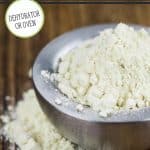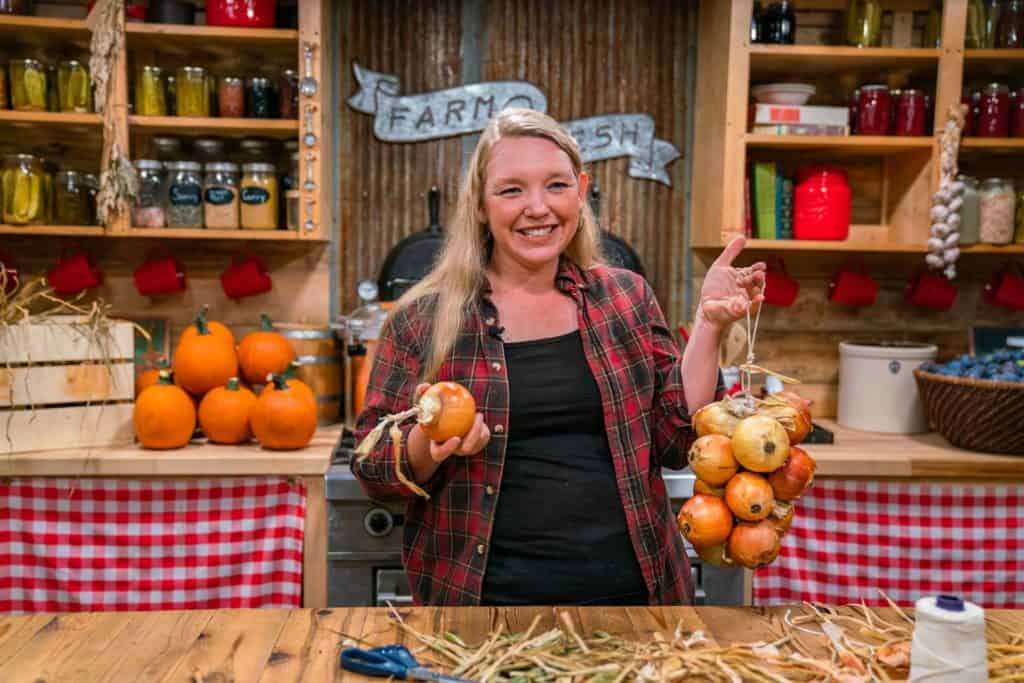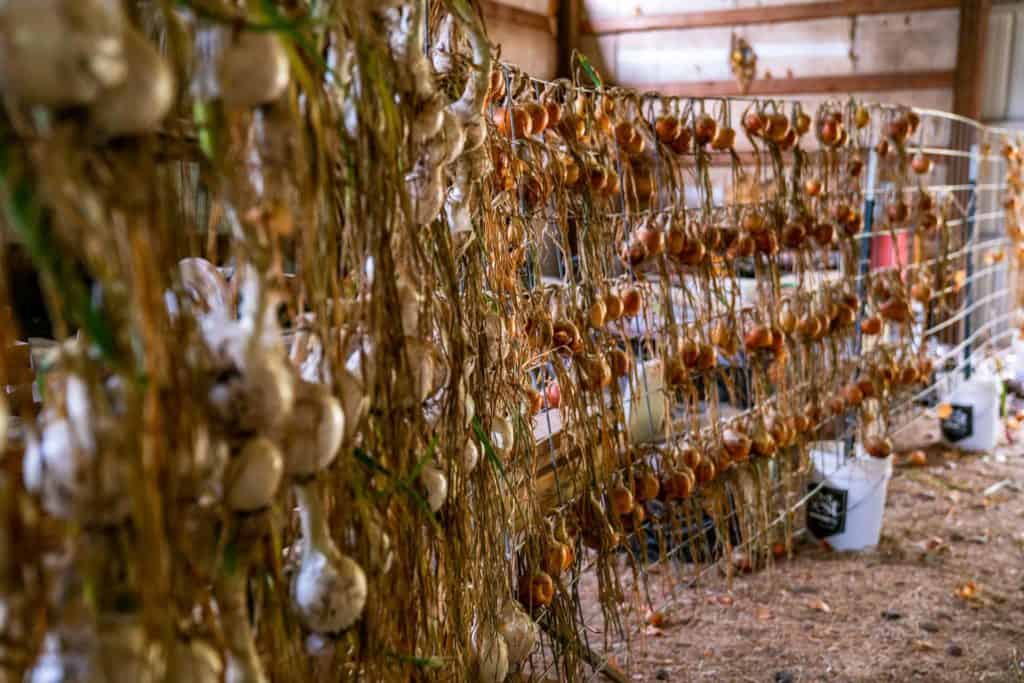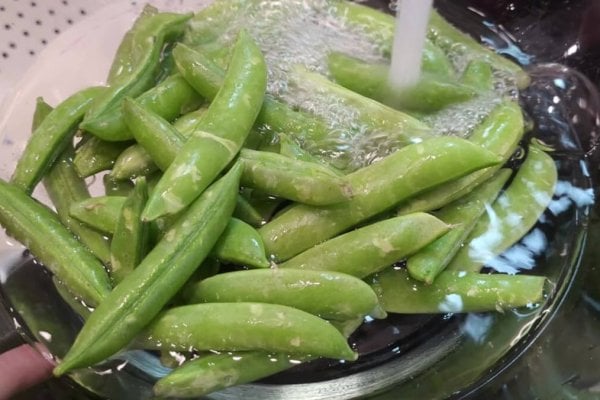

It’s so easy to turn onions into homemade onion powder (with a dehydrator or oven), and you can do this any time of year from freshly harvested onions, or onions you’ve been storing from last year’s harvest. It’s also a great option for using onions that have turned a little softer and that need to be used quickly. There are so many ways to use homemade onion powder!

Why I Love Homemade Onion Powder
First of all, anytime you’re making something from scratch at home, the flavor is always better than the store-bought version. This goes for homemade garlic salt, homemade celery salt, homemade mustard, homemade bread, homemade corned beef, from scratch pumpkin puree, and even brownies (especially homemade fudgy sourdough brownies!). And onion powder is no exception!
The other reason I love this so much is that from one onion I get nearly a cup of homemade onion powder. Now if you compare the cost of homemade to store-bought, that’s a HUGE difference in price! So I’m getting a more flavorful product for a fraction of the cost with just a little hands-on work on my end. I’d say that’s a win-win!
Supplies Needed
You don’t need much to make your own onion powder at home. There are a few supplies that will make the job easier, but I’ve also written out instructions below if you don’t have some of these items.
- Dehydrator – To make homemade onion powder you first have to dry your onion. To do this I’m using my favorite Excalibur dehydrator, but any dehydrator will do. If you don’t have a dehydrator, I give tips for how to make onion powder using your oven below.
- Dehydrator liners – I’m using fruit leather liners for this project, however it’s important to note that the onion smell will linger on your liners, so if you can purchase a set of liners just for drying things like onions, garlic, and peppers, I would highly recommend this.
- Knife/Cutting Board – For slicing your onions (you could use a food processor for this if you have a slicing attachment blade).
- Blender, Food Processor, or Spice Grinder – For grinding the dried onion slices into onion powder. You could use a mortar and pestle for this, but a blender is going to make the process much faster. I wouldn’t recommend using a coffee grinder, unless it’s designated solely for grinding spices!
- Storage Jar – I love Mason jars, so a simple Mason jar and lid will do! But you could also repurpose spice jars!

How to Make Homemade Onion Powder
- To start you want to remove the loose peels of each onion (be sure to save those scraps to make homemade bone broth!).
- Cut off both ends of the onion and slice in half, then remove any remaining peel off the onion (save those for broth, too).
- Because we’re making dried onion powder, we don’t have to be too precise about our cutting. If you’re wanting to make dehydrated onion pieces, then it’s helpful to try and chop your onions into uniform pieces so they’re all drying at the same speed (using a mandolin or a food processor with the correct attachment can really help with this process).
The smaller you slice your onions the faster they’re going to dry. - Using your dehydrator trays, lined with fruit leather sheets, spread your chopped onion pieces evenly.
PRO TIP: As mentioned above, when using dehydrator sheets, I strongly recommend buying a specific set just for dehydrating stronger foods like onions, garlic, and peppers because that strong flavor and smell can linger on those sheets and you don’t want your next batch of homemade fruit leather to taste like onions!
Likewise, while the dehydrator is running, it will make your house smell like onions, and your eyes may even start to water if you walk by! If you have the opportunity to move your dehydrator outside or into a garage or other area of the house, I’d highly recommend it. - Set your dehydrator to 150° F and let it run until your onion slices are completely dry and crispy (or about 6-8 hours).
- Check to see if your onions are dry by snapping an onion in half. They should snap easily with a nice sound. Do check multiple onions, especially any larger pieces to make sure all are completely dry.
- Using a food processor, high-powered blender, or even a spice grinder, place the dried onion slices into the container and whirl until powdered.
A note on using a coffee grinder: The onions tend to leave a smell behind, so you want to make sure you’re using something that you can wash well!

How to Dehydrate Onions for Onion Powder Without a Dehydrator
If you don’t have a dehydrator, you can use your oven to dehydrate your onion slices. Depending on your oven, if it doesn’t go any lower than 170° F, you may need to cycle through turning your oven on and off every hour or so. Another option is to prop your oven door open with a wooden spoon so the heat doesn’t get too high. Also, if your oven has a “keep warm” setting, this is usually set to 100° F and can work for dehydrating your onions, it will just take a bit longer.

How to Store Onion Powder
Once your onion powder is finished, you can store it long-term in a Mason jar or other spice jar.
We like to make up a whole bunch at once (enough for the entire year) and store it in large Mason jars with chalk labels so we know what’s in the jar.
For best flavor and nutrition, use onion powder within one year.

How to Use Onion Powder
You can now use your homemade onion powder the exact same way you would store-bought onion powder. Some of our favorite ways to use it are:
- Seasoning for chicken, beef, or a roast
- Mix into broth or soups for added flavor (like homemade cream of chicken soup)
- Stir into sour cream or cream cheese with dill and a little salt for a delicious veggie dip
- Make your own homemade spice blends
- Season dishes like black bean enchiladas

More Posts You May Enjoy
- Garlic and Herb Seasoning: Elevate Your Cooking!
- Growing Onions From Seed
- How to Store Onions the Right Way (for Long-Term Storage)
- Creamed Onions: A Delicious Side Dish Recipe
- Classic Tennessee Onions Recipe (Southern Comfort Food)
- How to Dry Fresh Herbs
- Homemade Garlic Salt
- Preserving Herbs in Salt – Two Ways
Did you make this recipe? We’d love for you to give it a star rating in the recipe card below, then snap a photo and tag us on social media so we can see! Follow along for more great recipes, tutorials, gardening and homesteading advice on Pinterest, Instagram, Facebook, and YouTube.

Homemade Onion Powder
Equipment
- Dehydrator or Oven
Ingredients
- 1 large onion
Instructions
- Remove the loose peels of each onion, cut off both ends and slice in half. Remove any remaining peel off the onion (save skins and peels for broth!).
- Slice onions in skinny uniform slices.
- Line dehydrator trays with onion slices in a single layer, it's ok if they overlap a bit.
- Dehydrate onion slices for 6-8 hours at 150 degrees F or until all onion pieces snap easily and are completely dry.
- Grind dried onion slices in a high-powered blender, food processor or spice grinder until a fine powder.
- Store in an air-tight container.
Notes
- If using the oven, see instructions in the post above.
- Try to slice onions uniformly so they all dry at the same speed.
- When checking if onions are dry, be sure to check the largest pieces, and check multiple pieces to ensure all onions are completely dry.
- You don’t want to proceed until onions are completely dry as this could spoil your onion powder.
- Store onion powder in an air-tight jar or spice container.


















